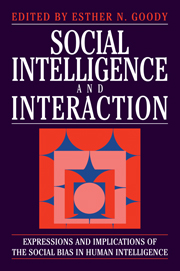 Social Intelligence and Interaction
Social Intelligence and Interaction Book contents
- Frontmatter
- Contents
- List of contributors
- Conventions used in transcripts
- Preface
- Introduction: some implications of a social origin of intelligence
- Part I Primary processes
- Part II The interactive negotiation of meaning in conversation
- Part III Genres as tools that shape interation
- Part IV Expressions of a social bias in intelligence
- 9 Divination as dialogue: negotiation of meaning with random responses
- 10 Social intelligence and prayer as dialogue
- 11 Interactional biases in human thinking
- 12 Stories in the social and mental life of people
- Consolidated bibliography
- Index
11 - Interactional biases in human thinking
Published online by Cambridge University Press: 09 January 2010
- Frontmatter
- Contents
- List of contributors
- Conventions used in transcripts
- Preface
- Introduction: some implications of a social origin of intelligence
- Part I Primary processes
- Part II The interactive negotiation of meaning in conversation
- Part III Genres as tools that shape interation
- Part IV Expressions of a social bias in intelligence
- 9 Divination as dialogue: negotiation of meaning with random responses
- 10 Social intelligence and prayer as dialogue
- 11 Interactional biases in human thinking
- 12 Stories in the social and mental life of people
- Consolidated bibliography
- Index
Summary
The human mind is something of an embarassment to certain disciplines, notably economics, decision theory and others that have found the model of the rational consumer to be a powerful one.
(Schelling 1988: 353.)Background
This chapter sets out to weave an improbable web through such topics as animism, common tendencies in the purchase of soap powder, extra-terrestrial lifeforms, the phrase ‘the whatdoyoucallit’, and the theory of communication. The thread, if it doesn't break, is the theme of a systematic bias in human thinking, in the direction of interactive thinking (E. Goody's anticipatory interactive planning or AIP). Because the argument is somewhat indirect, let me state the thesis right here in the beginning in semi-syllogistic form:
Communication is logically impossible
Nevertheless we humans can communicate
Therefore, we must use non-logical heuristics and a special form of reasoning to bridge the gap
For communication to work routinely, these heuristics must be dominant in our thinking all the time
Therefore, these heuristics spill over to bias our thinking in non-communication domains.
As in the famous conclusion to Wittgenstein's Tractatus, where we are advised not to think that which cannot be thought, so there is a certain paradox in thinking about biases in human thinking. (You can climb outside human thought, Wittgenstein hinted, just so long as you throw the ladder away and climb quickly back in.) We can only do so with real confidence, perhaps, where we can discern an indubitably correct way of thinking, guaranteed by the laws of mathematics or logic, from which human thinking tends to deviate.
- Type
- Chapter
- Information
- Social Intelligence and InteractionExpressions and implications of the social bias in human intelligence, pp. 221 - 260Publisher: Cambridge University PressPrint publication year: 1995
- 99
- Cited by


